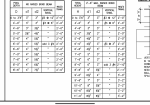In reviewing my plans, the engineering seems to be calling for fairly tight vertical spacing. The plan is for (what I believe) a pretty standard geometric pool, 3.5’ to 6.5’ water depth, with a raised wall on one side. Build is in Texas, so land doesn’t get much more flat.
Looking at the plans, what seems to be driving it is the PCF value that correlates to equivalent fluid pressure?
the horizontals are simply 12” oc per the plan, but vertical spacing at 6” and 3” seems like pretty tight. Maybe I’m reading this wrong? D is water depth and H is D plus any raised wall height.
d1 and d2 are gunite specs.

Looking at the plans, what seems to be driving it is the PCF value that correlates to equivalent fluid pressure?
the horizontals are simply 12” oc per the plan, but vertical spacing at 6” and 3” seems like pretty tight. Maybe I’m reading this wrong? D is water depth and H is D plus any raised wall height.
d1 and d2 are gunite specs.

Last edited:

